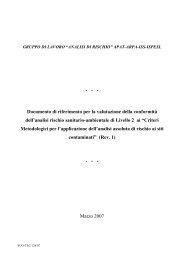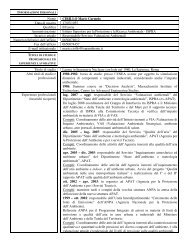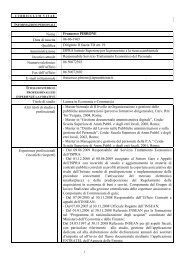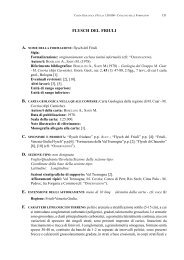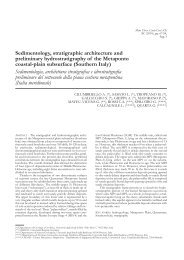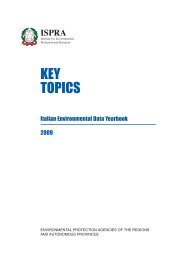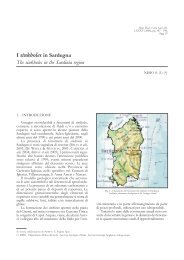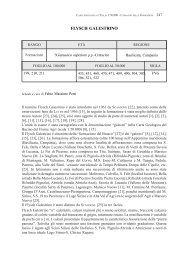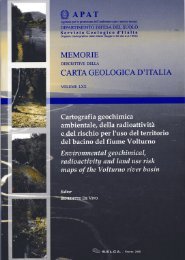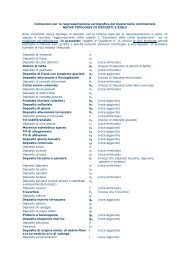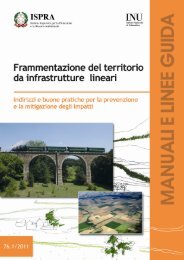Guidebook - Ispra
Guidebook - Ispra
Guidebook - Ispra
You also want an ePaper? Increase the reach of your titles
YUMPU automatically turns print PDFs into web optimized ePapers that Google loves.
Volume n° 1 - from PR01 to B15<br />
B12<br />
B12 -<br />
Leader: M. Sandulescu<br />
olites, gabbros, dolerites (Iancu, 1982, 1986; Iancu,<br />
Mărunţiu, 1994). The metamorphic parageneses point<br />
to a polymetamorphic history.<br />
The Moniom Group consists of the volcano- sedimentary<br />
Valea Satului Formation (Upper Devonian-<br />
Lower Carboniferous). It includes mainly mafic<br />
metatuffs with interlayered metapelitic and carbonatic<br />
rocks, scarce acid metatuffs and small bodies of gabbros<br />
and diorites-granodiorites.<br />
Their metamorphism is low-grade (Iancu, 1982;<br />
Iancu, Mărunţiu, 1994).<br />
In Serbia, the highest structural unit corresponding<br />
to the Western Supragetic is the Morava Nappe. The<br />
main part of its basement consists of the “Vlasina<br />
Series” (Dimitrijevic´, 1997). It is overlain at Bosilegrad,<br />
in south-eastern Serbia, by the anchimetamorphic<br />
Lisina beds, the Tremadocian age of which<br />
is constrained by Brachiopods. Consequently, the<br />
Vlasina Series could be compared to the Locva “Series”<br />
or to the Bocșiţa-Drimoxa Formation.<br />
Mesozoic formations. The Bocșiţa-Drimoxa Formation<br />
is overlain, west of Reșiţa, by limestones, the<br />
age of which could be ascribed to the Upper Jurassic-<br />
Lower Cretaceous.<br />
E a s t e r n S u p r a g e t i c U n i t s. M e t a m o r p h i c b a s e m<br />
e n t. East of the Olt, the Supragetic basement is represented<br />
mainly by two groups: Cumpăna and Făgăraș.<br />
The C u m p ă n a G r o u p is composed of the Cumpăna<br />
linear Gneiss (originating in a polymetamorphic granite),<br />
the Cozia Augengneisses and the Măgura Câinenilor<br />
Micaschists (+ kyanite, staurolite).<br />
The F ă g ă r a ș G r o u p consists of a sequence of micaschists,<br />
crystalline limestones and dolomites, para-amphibolites<br />
and graphite schists; an intensive retrogressive<br />
overprint developed over large areas.<br />
The L e a o t a G r o u p is considered by Săndulescu<br />
(1984) and others as belonging to the Getic Nappe. Its<br />
sequence consists of the Voinești Formation (Upper<br />
Precambrian, according to palynological data), similar<br />
to the Bocșiţa-Drimoxa Formation, the Bughea<br />
Amphibolite, the Lerești Formation (definitely Lower<br />
Ordovician, according to palynological data) of albite-porphyroblast<br />
schists and albite gneisses and the<br />
Călușu Formation (Devonian ?) consisting of greenschists.<br />
The Bughea Amphibolite is intruded by the<br />
Albești Granite (473-486 M.a., K / Ar).<br />
Serbo-Macedonian Massif. The Serbo-Macedonian<br />
massif falls outside our observation area. It is considered<br />
by some authors (Săndulescu, 1984; Dimitrijevic´,<br />
1997) as part of the same structural unit as the<br />
Supragetic. However the two units are separated by a<br />
major shear zone (Dusˇanovo, Rozaj-Bovan or Vrvi<br />
Kobila line, Kräutner, Krstic´, 2002). North of the<br />
Danube, the western parts of the Vrsˇac (Serbia) and<br />
Buziaș (Romania) crystalline “islands” belong to the<br />
Serbo-Macedonian massif str.s.<br />
Main tectonic features. Similarly to the South<br />
Apusenides, the geotectonic evolution of the South<br />
Carpathians was polyphasic: 1) During the Mesocretaceous<br />
tectogenesis, the Getic Nappe was overthrust<br />
onto the Severin Nappe. 2) During the Laramian tectogenesis,<br />
the Severin Nappe bearing the Getic Nappe<br />
“piggy-back” was overthrust onto the Danubian (Codarcea,<br />
1940). The overthrust of the Upper Danubian<br />
onto the Lower Danubian as well as that of the Western<br />
Supragetic onto the Getic probably belong to the<br />
first phase. Each of the main Alpine units described<br />
above is complicated by pre-Variscan, Variscan and<br />
even Alpine subunits. The age of overthrust of the<br />
Eastern Supragetic is controversial.<br />
B a n a t i t i c L a t e C r e t a c e o u s m a g m a t i s m. In the<br />
Romanian South Carpathians, the Upper Cretaceous<br />
magmatism was mainly intrusive and developed<br />
along three lineaments; it is represented by calc-alkaline<br />
plutons (granodiorites, granites, diorites) as well<br />
as by hypabissal minor intrusions of porphyry quartzdiorites,<br />
monzogranites, andesites, dacites, rhyolites<br />
and lamprophyres. Only in the Rusca Montană Upper<br />
Cretaceous basin overlying both the Getic and Supragetic<br />
an andesitic volcano-sedimentary formation<br />
is exposed. Isotopic K / Ar ages are comprised between<br />
91 and 65 M.a. (Berza et al., 1998).<br />
Field itinerary<br />
DAY 1<br />
Suceava - Gura Humorului - Câmpulung Moldovenesc<br />
- Vatra Dornei<br />
Aims : This is one of the northernmost profiles (excepting<br />
the Maramureș) across the whole East Carpathian<br />
structure. Along it there is the possibility to<br />
examine the Subcarpathians, the Flysch Zone and the<br />
Central East Carpathians (with their superposed nappes).<br />
The XV th century frescoed Voronet monastery<br />
will be visited.<br />
From Suceava the fieldtrip leaves toward the west,<br />
following main road no. 17. Until Păltinoasa, about<br />
30 km from Suceava, the Sarmatian formations of the<br />
Foreland will be crossed. At Păltinoasa, the frontal<br />
part of the Flysch nappes is well expressed.



